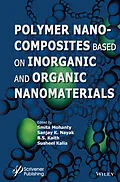This book covers all aspects of the different classes of nanomaterials from synthesis to application. It investigates in detail the use and feasibility of developing nanocomposites with these nanomaterials as reinforcements. The book encompasses synthesis and properties of cellulose nanofibers, bacterial nanocellulose, carbon nanotubes / nanofibers, graphene, nanodiamonds, nanoclays, inorganic nanomaterials and their nanocomposites for high-end applications such as electronic devices, energy storage, structural and packaging. The book also provides insight into various modification techniques for improving the functionality of nanomaterials apart from their compatibility with the base matrix.
Autorentext
Smita Mohanty is working as a Senior Scientist at the Laboratory for Advanced Research in Polymeric Materials (LARPM), an exclusive R&D wing of Central Institute of Plastics Engineering & Technology (CIPET), at Bhubaneswar, India. She has 55 research publications and 5 patents to her credit.
Sanjay Kumar Nayak is the Professor & Chair of LARPM. For 4 years he has been heading the operations of 15 CIPET centers situated at 22 locations in India. He has published more than 150 research papers and 5 patents.
B. S. Kaith is a professor in the Department of Chemistry at Dr. B.R. Ambedkar National Institute of Technology Jalandhar, India and has more than 150 research papers in national and international journals.
Susheel Kalia is Assitant Professor in the department of Chemistry, Bahra University, India.
Zusammenfassung
This book covers all aspects of the different classes of nanomaterials from synthesis to application. It investigates in detail the use and feasibility of developing nanocomposites with these nanomaterials as reinforcements. The book encompasses synthesis and properties of cellulose nanofibers, bacterial nanocellulose, carbon nanotubes / nanofibers, graphene, nanodiamonds, nanoclays, inorganic nanomaterials and their nanocomposites for high-end applications such as electronic devices, energy storage, structural and packaging. The book also provides insight into various modification techniques for improving the functionality of nanomaterials apart from their compatibility with the base matrix.
Inhalt
Part I: Nanomaterials
1 Cellulose Nanofibers: Synthesis, Properties and Applications 3
Mahuya Das and Rupa Bhattacharyya
1.1 Introduction 3
1.2 Synthesis of Cellulose Nanofibers 4
1.3 Properties of Cellulose Nanofibers 14
1.4 Applications of Nanocellulose Fibers 28
1.5 Conclusion 32
References 33
2 Bacterial Nanocellulose: Synthesis, Properties and Applications 39
M.L. Foresti, P. Cerrutti and A. Vazquez
2.1 Introduction 39
2.2 Bacterial Nanocellulose Synthesis 41
2.3 Bacterial Nanocellulose Properties 49
2.4 Bacterial Nanocellulose Applications 52
2.5 Conclusions 57
References 58
3 Carbon Nanofibers: Synthesis, Properties and Applications 63
Tanmoy Rath
3.1 Introduction 63
3.2 Carbon Nanofiber Structure and Defects 65
3.3 Synthesis 67
3.4 Growth Mechanism of CNFs 77
3.5 Properties 78
3.6 Applications 82
3.7 Conclusion 84
References 85
4 Carbon Nanotubes: Synthesis, Properties and Applications 89
Raghunandan Sharma Poonam Benjwal and Kamal K. Kar
4.1 Introduction 89
4.2 Carbon Nanostructures 91
4.3 Structure: Chirality 97
4.4 Synthesis 99
4.5 Characterizations 103
4.6 Properties 108
4.7 Applications 112
4.8 Conclusions 131
Acknowledgement 132
References 132
5 Graphene: Synthesis, Properties and Application 139
Subash Chandra Sahu, Aneeya K. Samantara, Jagdeep Mohanta, Bikash Kumar Jena and Satyabrata Si
5.1 Introduction 140
5.2 History of Graphene 142
5.3 Natural Occurrence 143
5.4 Carbon Allotropes 144
5.5 Molecular Structure and Chemistry of Graphene 147
5.6 Properties of Graphene 147
5.7 Synthesis of Graphene 153
5.8 Biomedical Application of Graphene 155
5.9 Graphene in Energy 166
5.10 Graphene in Electronics 174
5.11 Graphene in Catalysis 177
5.12 Graphene Composites 177
5.13 Conclusion and Perspective 179
Acknowledgement 180
References 181
6 Nanoclays: Synthesis, Properties and Applications 195
Biswabandita Kar and Dibyaranjan Rout
6.1 Introduction 195
6.2 Structure and Properties of Nanoclays 196Contents ix
6.3 Synthesis of Polymer-Clay Nanocomposites 203
6.4 Applications of Nanoclays 206
6.5 Conclusion 211
References 212
7 Applications for Nanocellulose in Polyolefins-Based Composites 215
Alcides Lopes Leao, Bibin Mathew Cherian, Suresh Narine, Mohini Sain, Sivoney Souza and Sabu Thomas
7.1 Introduction 215
7.2 Flexural Strength 224
References 227
8 Recent Progress in Nanocomposites Based on Carbon Nanomaterials and Electronically Conducting Polymers 229
Jayesh Cherusseri and Kamal K. Kar
8.1 Introduction 230
8.2 Electronically Conducting Polymers 230
8.3 Carbon Nanomaterials 233
8.4 Why Nanocomposites? 235
8.5 Electronically Conducting Polymer/Fullerene Nanocomposites 236
8.6 Electronically Conducting Polymer/Carbon Nanofiber Nanocomposites 240
8.7 Electronically Conducting Polymer/Carbon Nanotube Nanocomposites 243
8.8 Electronically Conducting Polymer/Graphene Nanocomposites 246
8.9 Applications 249
8.10 Conclusions 252
Acknowledgement 253
References 253
Part II: Nanocomposites Based on Inorganic Nanoparticles
9 Nanocomposites Based on Inorganic Nanoparticles 259
